Morning temperatures clung above freezing when we pulled our minivan onto the dirt roads of Elm Creek Ranch, southeast of Shamrock, Texas. It was March 2015, and we were searching for seed of Kentucky coffeetree (Gymnocladus dioicus). Although we never would have expected to find the species growing in the Texas Panhandle, beyond the range shown on distribution maps, a 2007 herbarium voucher confirmed it was “locally common” on the property. The ranch manager, J. C. Brooks, led us to the namesake waterway, which has cut a deep ravine through the dry grasslands. Most of the tree species followed this creek, and sure enough, tucked near stands of mesquite (Prosopis glandulosa) and western soapberry (Sapindus saponaria var. drummondii), several coffeetrees were growing.
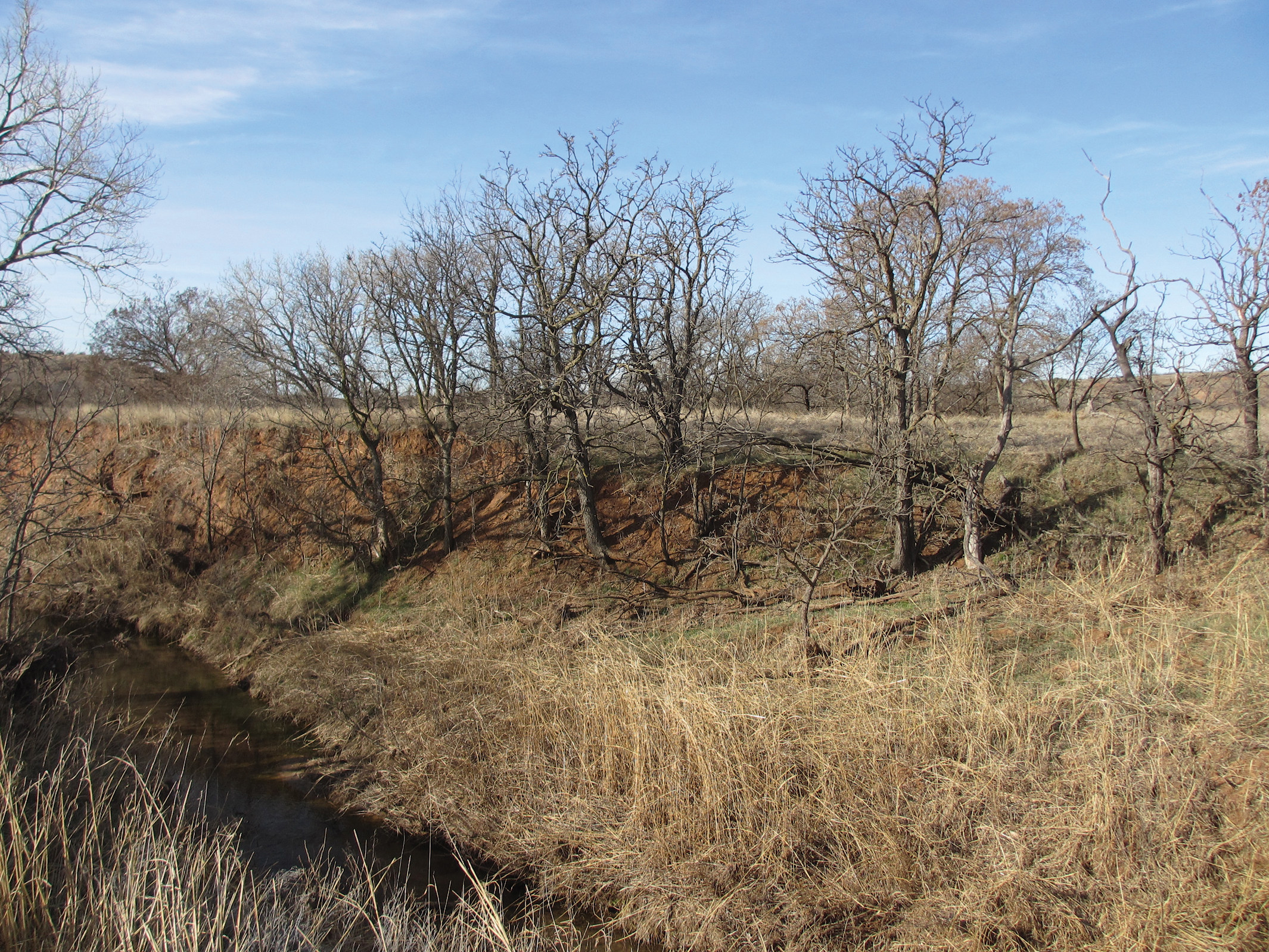
The coffeetrees stood small and stunted—the largest barely exceeding thirty feet—and the pickings were slim, with only a handful of the thick leguminous pods dangling in each tree. We quickly went to work shaking the pods free and recording measurements and habitat data. Three hours later, the temperature had rocketed to 74°F (23°C), and we drove away almost giddy about collecting Kentucky coffeetree in Texas.
By this collection on the fifth day of a nine-day expedition, our van was filling with bags of the beautiful yet odoriferous pods—collected from sites in Oklahoma and Kansas, in addition to Texas. The dash had become covered with stout sticks, which would eventually become herbarium vouchers. At a gas station one afternoon, a man noticed our unusual dash collection and interjected with understandable and friendly curiosity, “Mind if I ask, what’s with the branches in your window?”
Coffeetree Collaboration
Our 2015 collecting expedition marked the sixth year of a partnership between the Brenton Arboretum, located in Dallas Center, Iowa, and the National Plant Germplasm System (NPGS) genebank in Ames, Iowa. The partnership has aimed to develop a comprehensive collection of Kentucky coffeetree—sampling populations from across the range of the species, which extends from Ontario through central Arkansas, from west-central Ohio through Oklahoma, along with parts of Kentucky and Tennessee. Although the trees in Texas were scraggly and small, many of the specimens we have seen throughout the years have been impressively grand, measuring well over one hundred feet tall.
We think Gymnocladus dioicus should be planted more widely in urban environments. The species has no serious insect or disease problems; it is drought tolerant and adaptable to tough soil conditions; moreover, it is exceedingly attractive, with distinctive bark (even at a young age), interesting compound leaves, and yellow fall color. The species should be included among the diverse tree genera that are used to replace ashes (Fraxinus), removed because of emerald ash borer (Agrilus planipennis), and oaks (Quercus), suffering from oak wilt (Bretiziella fagacearum). Yet if Gymnocladus is planted more broadly, we realize that a collection of diverse germplasm will be needed—both now and far in the future—to make selections adapted to regional climatic conditions and to preserve germplasm for potential reintroduction into the wild.
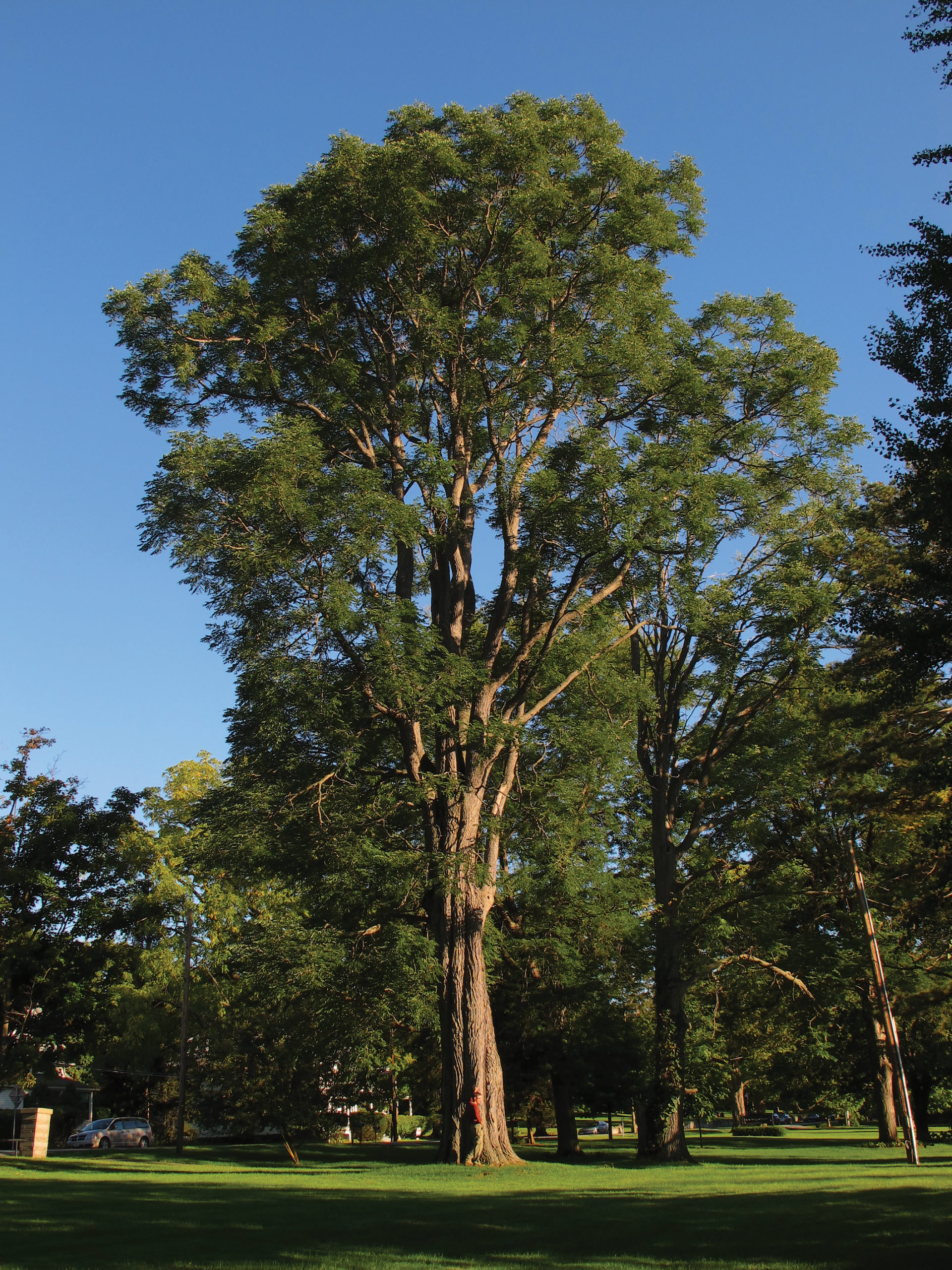

The Brenton Arboretum’s first collecting trip occurred in 2008, but plans for the project originated in 2004, as the institution contemplated developing a Nationally Accredited Plant Collection through the American Public Gardens Association’s Plant Collections Network (PCN) program. Botanical research had been part of the Brenton’s mission since it was established in 1997. After meeting with Mark Widrlechner, horticulturist at NPGS and the PCN’s Iowa recruiter, Kentucky coffeetree was determined to be an excellent focus. Gymnocladus dioicus was not currently a PCN collection, and the NPGS had only six viable seed accessions of the species from known wild origins. Moreover, everyone agreed Gymnocladus was definitely underused in urban landscapes.
Prior to 2004, the Brenton had eleven accessions of Kentucky coffeetree, but none were wild collected. Andy Schmitz, the director of horticulture, made the Brenton’s first wild collection of Gymnocladus in 2008 at Ledges State Park in Boone County, Iowa. He made a few additional collections the following year, but he knew that as the only horticulturist at an arboretum operating under a small budget, additional help was needed to make their future PCN collection a reality. This solidified a long-term relationship between two Iowa horticulturists: Andy Schmitz and Jeffrey Carstens at NPGS.
Collecting Seed and Data
One of the many benefits of having two institutions striving towards a common goal of preserving genetic plant diversity is the shared work load, especially during the preparation for a collection trip. The success of each trip is largely dependent on the initial identification of specific collecting locations. For the 2015 expedition, for instance, herbarium records and floristic surveys were referenced to identify the anomalous population in Texas, as well as other populations near roadsides and deep canyons, creeks and national battlefields. Further communication with property owners and local botanists—including those who collected the original herbarium specimens—is also beneficial, whenever possible.
Local contacts occasionally provide us with GPS coordinates for fruiting specimens, but our efforts typically depend on a pair of high-quality binoculars. The characteristic brown pods are easily recognized from considerable distances (even when observed at sixty-five miles an hour) and resemble a flock of blackbirds perched high in the canopy. Thankfully, the fruits are persistent from October through May, allowing us to collect in the winter, when they are highly visible in the leafless canopy. (What other species provides a more than six-month window of fruit senescence?) Collections in early to mid-winter were difficult, however, because the stringy and tough peduncle does not release the fruits as easily, whereas roughly six weeks before bud break, the fruit is easily shaken from the tree.
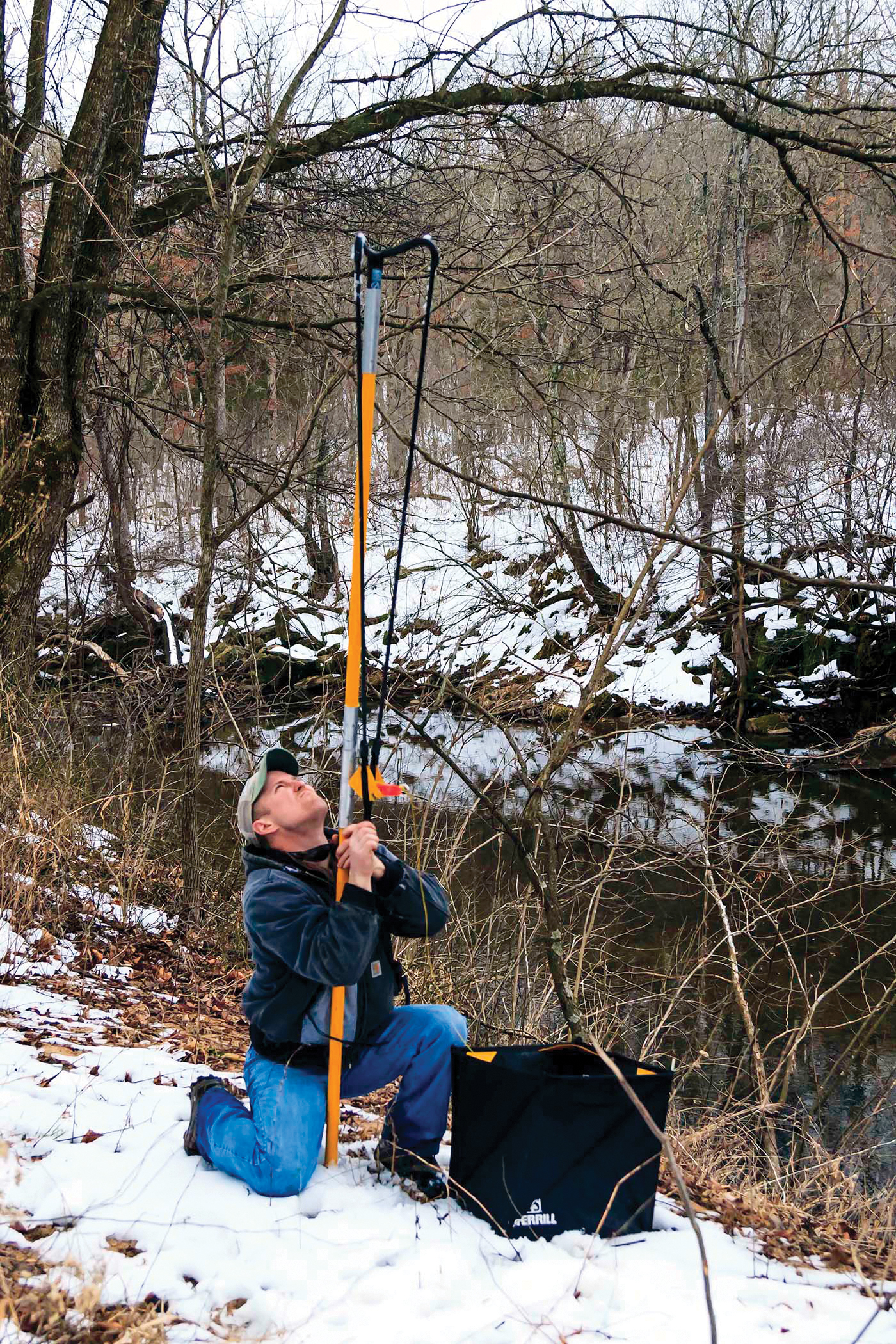

After we have spotted the trees, teamwork makes the seed and data collection easier. Our collection on March 4, 2013, illustrates our basic procedure. On the third day of a nine-day expedition through southern Indiana and Kentucky, we were truly looking forward to exploring Griffith Woods, south of Cynthiana, Kentucky, which is known for harboring the world’s largest chinkapin oak (Quercus muehlenbergii) within an exceptional old-growth savannah. As soon as we pulled into the parking lot, we could see fruiting coffeetrees on the distant horizon. Although we harvested from seven trees, the find of the entire trip was the sixth—discovered some four hours later. This was the second-largest coffeetree we had ever seen, measuring 120 feet (36.6 meters) tall, 46.5 feet (14.2 meters) wide, and 42.0 inches (1.1 meters) in trunk diameter at breast height, and it currently reigns as the Kentucky state champion. To harvest seeds from such a large tree, we used a Big Shot® line launcher to accurately propel a weighted bag and line over branches high in the canopy. We then used the line to shake pods free. The launcher—a slingshot mounted on an eight-foot pole—has proved its worthiness over and over. On early trips, before using the launcher, we averaged up to two hundred seeds per tree, but now we average six hundred to eight hundred.
The collection time at each mother tree takes around forty-five minutes. Jeff is the “shaker” while Andy is the “gatherer.” Ideally, enough pods are shaken to the ground to fill one or two five-gallon buckets. While the pods are gathered and packed into labeled sacks, we record GPS coordinates, elevation, associate species, habitat notes, and descriptions of plant health and abundance. Over the years, we expanded our data collection to include height and trunk girth (diameter at breast height) for each mother tree, along with trunk measurements for all woody species over four inches (ten centimeters) within a prescribed area (calculated with a small lens, known as a ten-factor wedge prism). We take herbarium vouchers of branches and fruits, which are later deposited at regional herbaria, and we also photograph each tree in the field. (Back at NPGS, we also scan images of the fruits and seeds for each tree, so that precise dimensions are documented.) Our goal is to capture the potential genetic diversity at every site. Sometimes we collect seed from six to eight mother trees, but this has ranged from two to ten. Sometimes the trees are found less than a few hundred yards apart in a forested area, and other times as much as five miles apart along a river corridor.
After we collected from the massive specimen at Griffith Woods, the afternoon sun was setting fast. We never found the record chinkapin oak, because everywhere we turned, massive lookalikes made us freeze in our tracks in admiration. We collected from one other coffeetree—our seventh for the site—and then, as we walked back to the van at twilight, we were startled by a black object moving in the tall grass ahead of us. When our eyes focused, we came to realize it was a skunk. Good thing for us (and for the hotel staff), the skunk disappeared without incident. Soon afterwards, several wild turkeys flew overhead, landing in the brush to roost for the night.
Observations on Abundance
To cover the entire native range of Kentucky coffeetree, we have targeted collection sites approximately seventy-five miles apart within distinct watersheds. We have also aimed to collect from every possible Omernik ecoregion (Omernik, 1987), in an effort to find the best representation of genetic diversity across as many unique habitats as possible. To date, we have made at least one collection from twenty of twenty-two ecoregions within the core range, although small disjunct populations could occur in another twelve. Our first extended collection trip occurred in 2010, when we spent eight days on the road making thirteen collections in six states (Iowa, Missouri, Arkansas, Illinois, Indiana, and Tennessee). On future trips, we usually focused on a single state or a few adjacent states, often targeting two collection sites per day, sometimes as much as one hundred miles apart. On all trips, our work started before sunrise and ended after sunset.
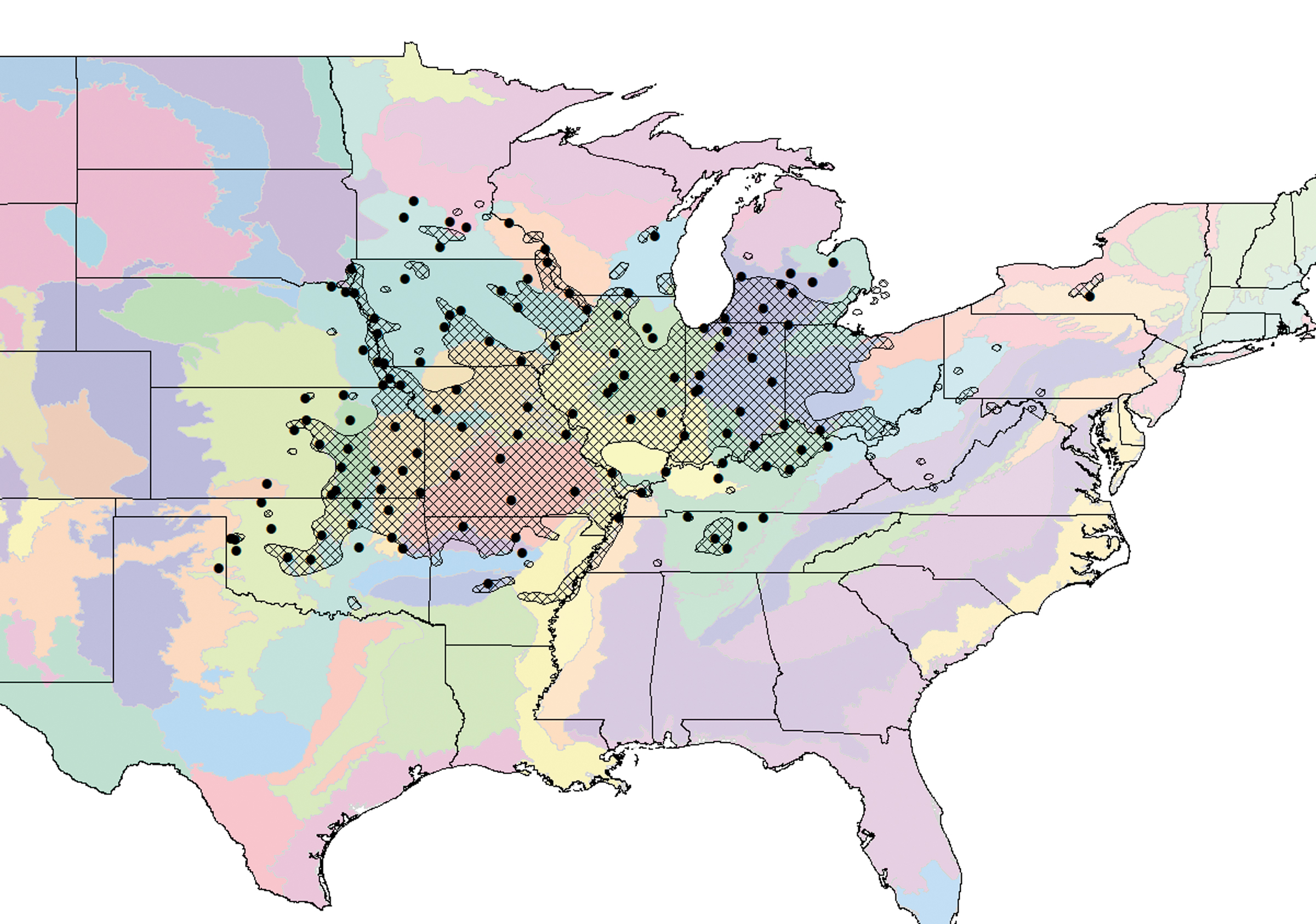
Looking at the range map for Gymnocladus dioicus in Elbert Little Jr.’s Atlas of United States Trees, we might assume the species would be well represented near the central part of the range and become scarcer towards the edges, but this assumption does not hold true. Missouri, for instance, is centered within the native range, and approximately 80 percent of the state’s counties document its presence (Kartesz, 2015). Yet out of nine Missouri populations that we’ve sampled, finding more than twenty-five trees proved difficult, especially in the southeastern corner of the state—nearly the center of the range. Jeremy Jackson, from the United States Army Corps of Engineers, supplied us with forestry plot data for the Wappapello Lake Project in Wayne County, which demonstrated that only three genetically distinct colonies occurred within the ten-thousand-acre property. Our first-hand observations confirmed this scarcity. This aligns with observations by Gifford Pinchot, the first chief of the United States Forest Service, whose 1907 report suggested that coffeetree was one of the rarest forest trees despite its rather extensive range and that, in large areas within the range, the species was “entirely lacking or represented only by an occasional individual.”
For this reason, we were especially intrigued by an 1899 report from the geologist Robert Ellsworth Call, which stated coffeetree was “of very common occurrence” along aspects of Crowley’s Ridge, a geological formation that runs from southeastern Missouri through northeastern Arkansas, paralleling the alluvial plain of the Mississippi River. We wanted to target Crowley’s Ridge during our first joint collecting trip, so we spent numerous hours searching the internet and communicating with botanists hoping to pinpoint locations. Only one botanist—a man who had spent more than thirty years studying the area—could tell us of a single population along the ridge. What changed over the past century that has caused the “very common” to become rare? Certainly this period coincided with environmental transformations rendered by agriculture, deforestation, grazing, and timber use. Based on our observations, Kentucky coffeetree is essentially rare throughout the eastern three-quarters of its native range.
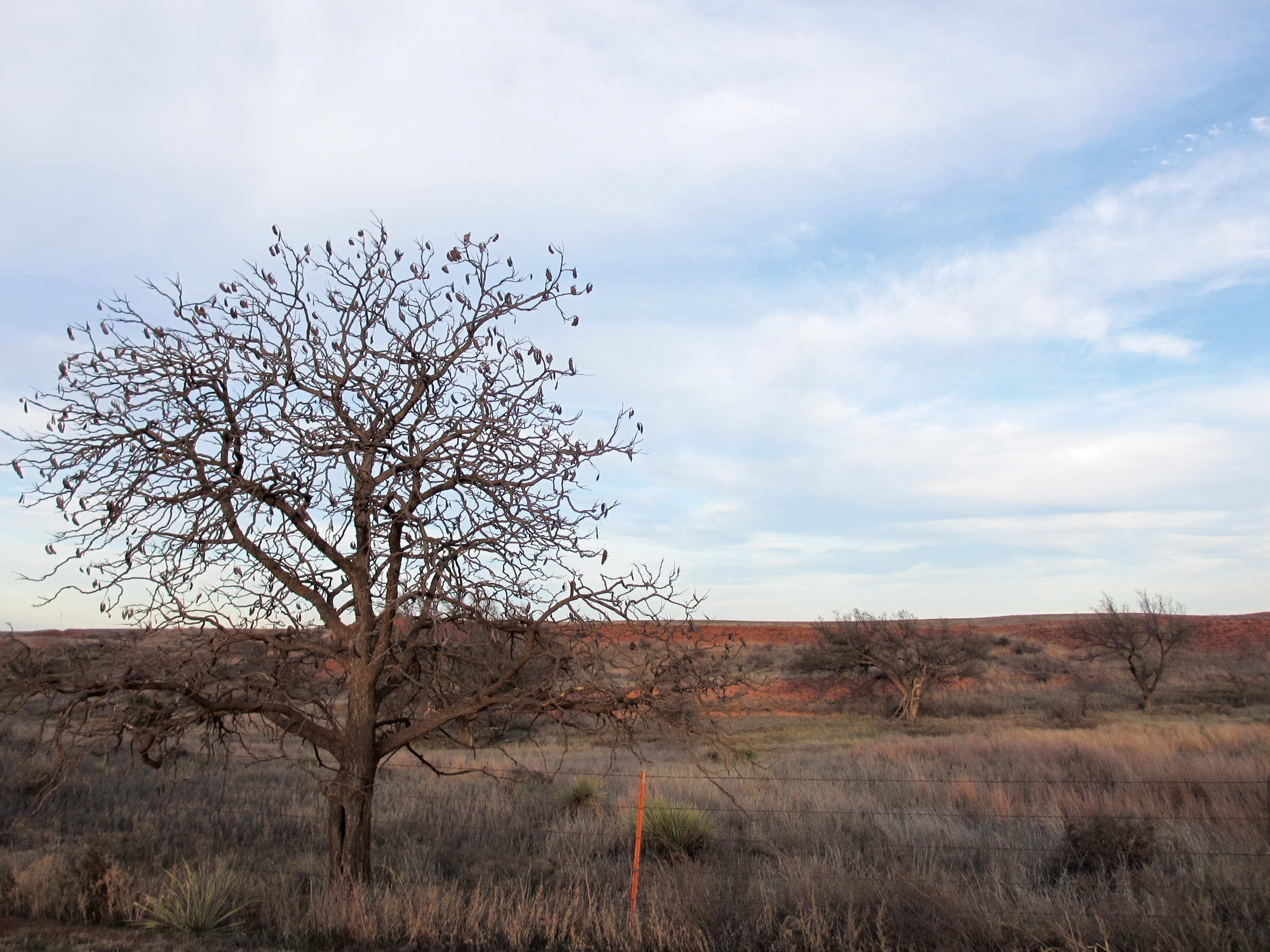

While Little’s map does not capture this off-centered distribution, general patterns hold true. In 2010, we spent almost a full day scouring areas south and west of Carbondale, Illinois, covering hundreds of miles in and near the LaRue-Pine Hills Research Natural Area, where limestone and sandstone outcroppings tower over the Mississippi River bottoms, yet we only found one lone tree at the base of Fountain Bluff. Our struggle to locate the species in this region aligns perfectly with Little’s map, which shows a distribution gap for southern Illinois. In Michigan, on the northern edge of the native range, numerous botanists have kept an eye out for coffeetree due to its rarity. During a seven-day tour of the state in 2016, we were able to locate coffeetree only at locations that had been provided to us and at no additional sites, thus confirming its rarity. In Minnesota, the map shows a few disjunct populations. Our sampling, again dependent on the observations of other botanists, found Gymnocladus dioicus to be infrequent but locally common along watersheds of the Minnesota and Blue Earth Rivers, which once again aligns with Little’s map.
Compared to other states sampled, Gymnocladus dioicus is quite abundant in Oklahoma and Kansas, where it could be considered a dominant forest species at some sites. Perhaps a combination of historical and current land management practices allow it to sustain and regenerate within these two states.
Observations on Habitat
When we initially started making seed collections of Gymnocladus near Iowa, we specifically targeted watersheds and bottomlands, as this is where we found the species naturally occurring; moreover, this preference for moist locations concurred with descriptions in scientific literature. Yet, over the ensuing years, our understanding of the species began to change. When we collected in central Michigan in 2016, we noted that even though the majority of the specimens were growing in extremely wet bottomlands, adjacent to major rivers, many displayed signs of root rot and decline. Whether these Kentucky coffeetrees really preferred to be in such wet conditions was questionable.
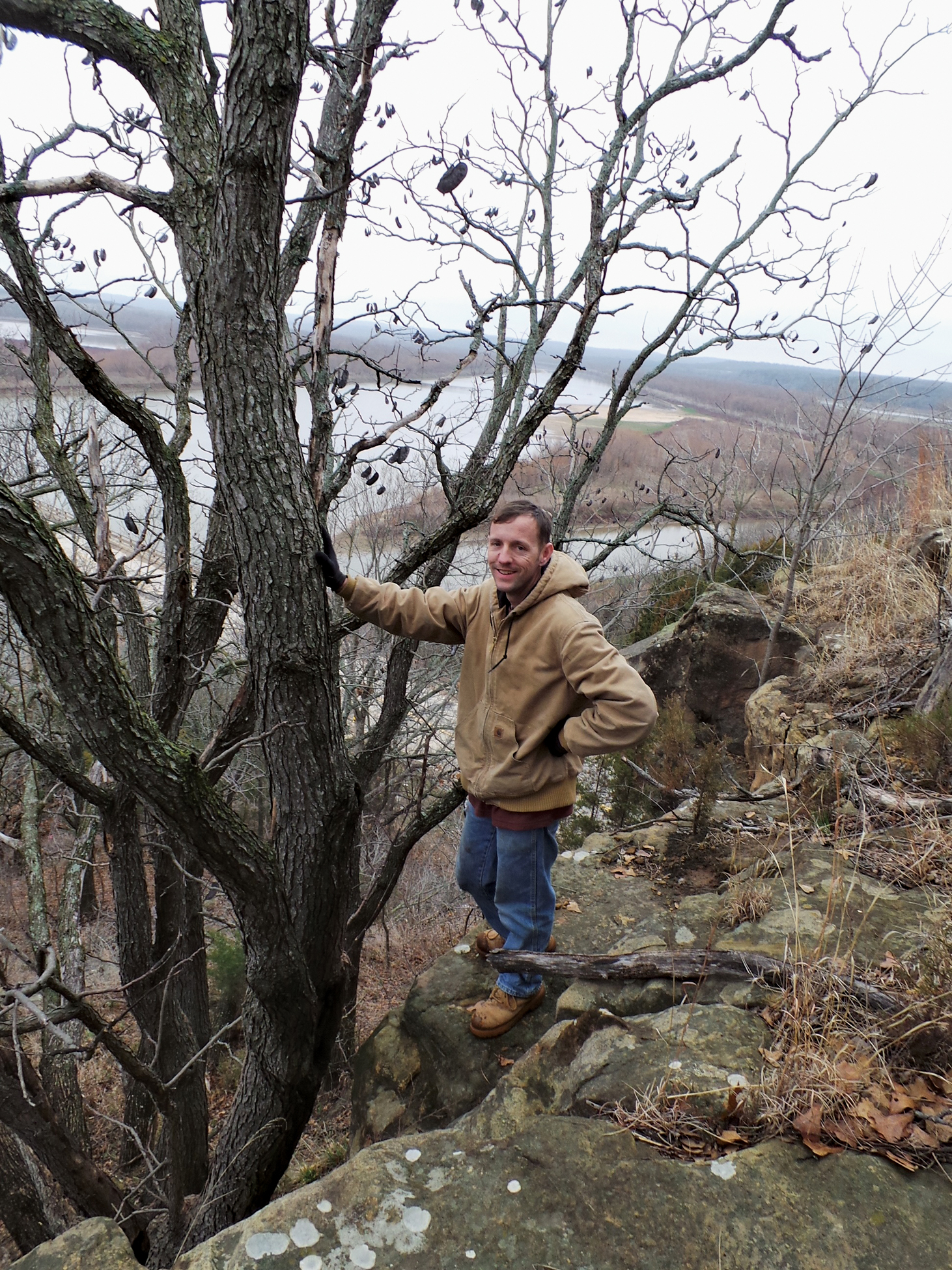
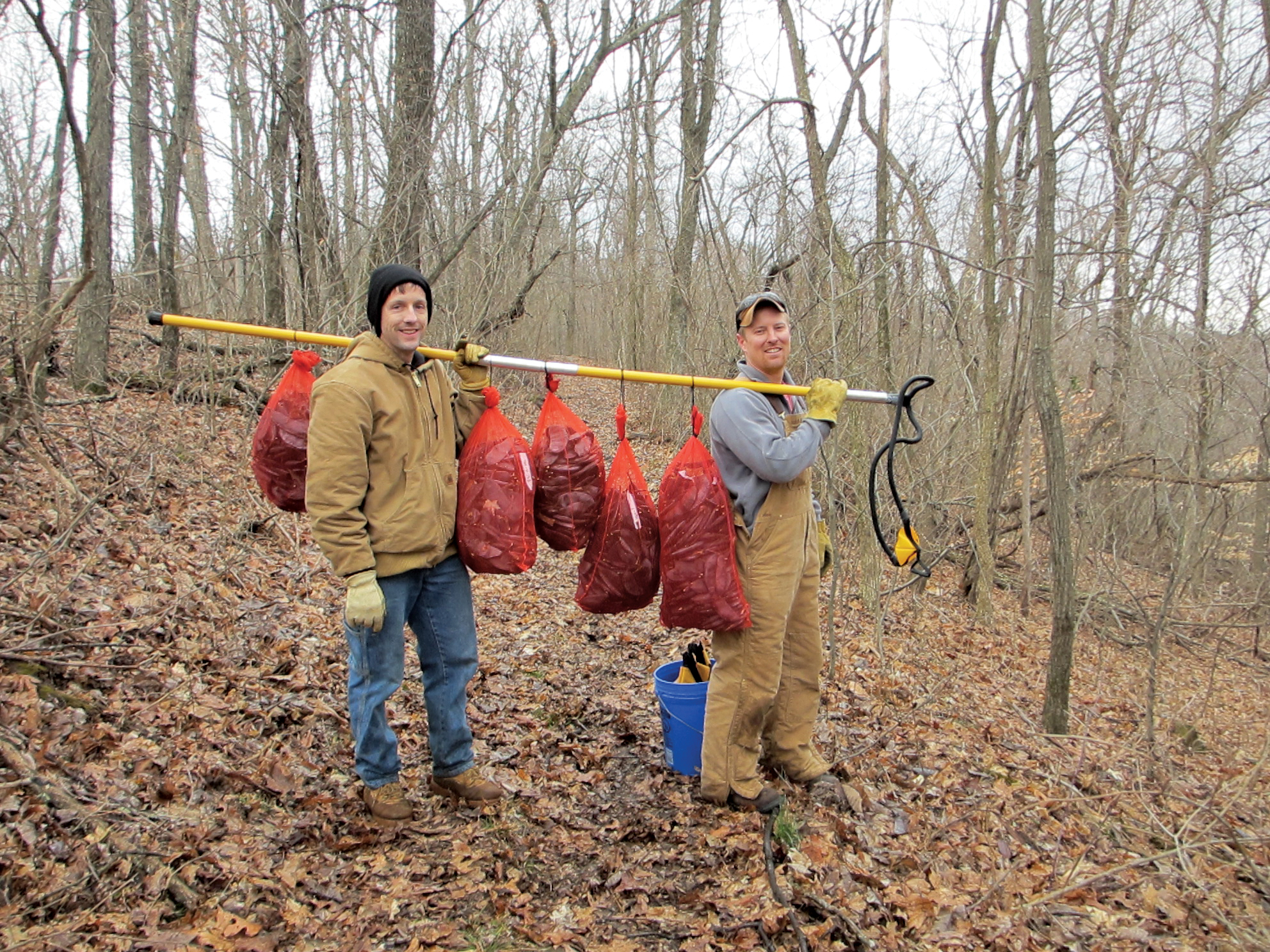
In southern Indiana and Kentucky, for instance, Gymnocladus dioicus occurs on upland bluffs and steep slopes with loose soils and occasionally on bedrock. The Loess Hills of western Iowa, which follow the Missouri River, support substantial specimens of G. dioicus on all aspects of their slopes. In Iowa and Illinois, human settlement and introduction of the plow has likely eliminated many G. dioicus in open fields and has left remnants only in areas too wet or steep for modern agriculture. Coffeetree was found in a variety of habitats in Missouri, including moist ravines, dry rocky slopes, and major and minor watersheds. On the western edge of its native range in Kansas and Oklahoma, coffeetree occupies dry ravines and hillsides, open pastures and bedrock. All six sites sampled in Tennessee were collected off cool north- to northeast-facing slopes, showing a definite variance compared to other states.
While most sites tend to have rather uniform habitats for all trees sampled, a few possessed specimens growing in remarkably different conditions. Along the Minnesota River in south-central Minnesota, coffeetrees grow on bottomland alluvial soils as well as on three-billion-year-old granite outcrops, emphasizing the ability of the species to perform on an extreme spectrum of harsh growing conditions. Specimens at the Tallgrass Prairie Preserve in northeastern Oklahoma demonstrate similar adaptability: we found trees growing on shallow sandstone outcrops with blackjack oak (Quercus marilandica) and post oak (Q. stellata), and in moist floodplains with sycamore (Platanus occidentalis) and black walnut (Juglans nigra).
Ten years ago, we assumed silver maple (Acer saccharinum) would be a common associate, given our original understanding that Gymnocladus dioicus was a floodplain species, but in the end, silver maple has been documented at only 12 percent of our sites. Today, our efforts to find coffeetree typically require a watchful eye for common hackberry (Celtis occidentalis), often growing where wet habitat grades into slightly higher elevations or sandier soils. We have observed hackberry—the most common associate—at 62 percent of our collection sites, including on the edge of the Cass River in Tuscola County, Michigan, where we discovered Gymnocladus about seventy miles north of the presumed northern limit for its range. Hackberry and coffeetree regularly share upland locations as well.
The common belief that coffeetree is adapted for wet sites in the landscape likely stems from the occurrence of coffeetree amongst bottomland forests of major watersheds in the states of Iowa, Illinois, Minnesota, and Indiana, where sand and loam soils provide adequate drainage. Seeing a strong presence of Gymnocladus in Kansas and Oklahoma, more than any other states, suggests the species is well adapted for dry, hot environments.
Threat of Impermeable Seeds
On March 5, 2013, the day after our collection at Griffith Woods, Kentucky, we began before sunrise, heading northeast for the Fleming Wildlife Management Area. This site occupies the eastern edge of the range for Gymnocladus in Kentucky. Scott Freidhof, a wildlife biologist for the area, had provided us with GPS coordinates for coffeetrees there, and this information proved essential. The trees were a three-quarter-mile hike up to the top of a bluff, and because the forest cover was dense, there was no using binocs to spy pods from afar. With the GPS unit in hand, we attempted to take the most direct route to this localized population and scrambled straight up a steep slope. At the top, pods littered the ground, and we swiftly scooped up twenty-five gallons. The slingshot pole came in handy, not for slinging the throw line but for stringing up the bags of pods like wild game from a hunt. With one end of the pole on each of our shoulders, we made our way down the steep slope, only stumbling a few times on loose rocks or wet oak leaves underfoot.
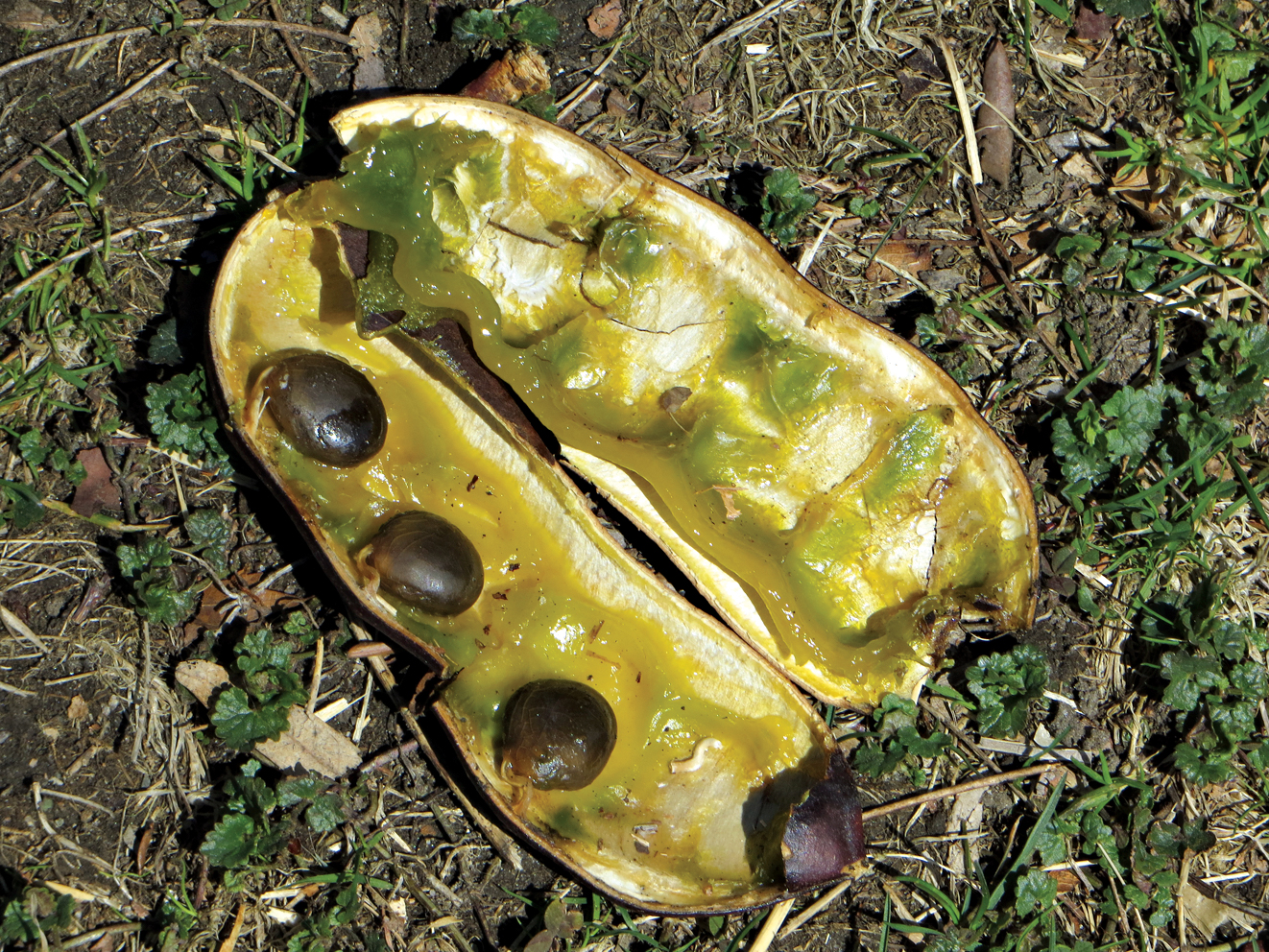
Why were so many seeds undisturbed on the ground? The Kentucky coffeetree has been referred to as a “botanical anachronism,” one that was once dispersed by large prehistoric mammals that are now extinct (Zaya and Howe, 2009). Grinding molars and intestinal juices of the American mastodon (Mammut americanum) may have aided in scarifying coffeetree seeds, and perhaps just as important, these animals would have served as a major dispersal mechanism (Barlow, 2008).
Al Fordham, a prominent propagator at the Arnold Arboretum, conducted a germination experiment on Gymnocladus in 1965. He placed three hundred seeds in water, and within the first ten days, thirteen seeds germinated. Fordham suggested “these, no doubt had fissures in their seed coats.” Over the next two years, only three more seeds germinated that were submerged in water. Coffeetree seeds are surrounded by a gelatinous material, which may serve as a protective barrier during the early to mid-maturation phases and perhaps later as a reward to animals willing to disperse them throughout the landscape, though which four-legged critters (if any) now move these fruits remains unclear.
Water may be a viable dispersal mechanism. We have observed pods falling into a river, and though able to float for a while, they eventually sink to the bottom, where abrasion provided by gravel and sand in the riverbed may provide the necessary scarification needed for germination. Yet how would such a heavy seed make its way back to shore to even have a chance at sprouting? At many collection sites, two- and three-year-old seeds can be found on the ground under the canopy of the mother tree, next to rotting pods from prior years. This is what writer Connie Barlow—drawing on the work of ecologists Dan Janzen and Paul Martin—described as the “riddle of the rotting fruit,” caused when seed lies in wait for an extinct animal that will never come to carry it away. Our observations recorded little to no regeneration at almost all of our collection sites, illustrating a potential threat for the species within its native habitats.
Habitat Loss and Ecological Changes
In 2015, the day before we collected Gymnocladus in Texas, we visited a site along the Washita River in Custer County, Oklahoma, where an existing NPGS accession (PI 649669) had been collected in 1993. Steve Bieberich, the owner of Sunshine Nursery in Clinton, Oklahoma, had collected the original accession. We met at his nursery, and he guided us to the site. Even with his help, we were unable to relocate any coffeetrees. By looking at historical photos, we realized a new highway bridge had eliminated Gymnocladus at this location back in 2005. This observation really hit home the importance of our collaborative effort to deposit seeds for long-term preservation. Fortunately, germplasm from this location is currently secure in the NPGS collection, and preserved seed could be used for reintroduction back into the Washita River watershed.
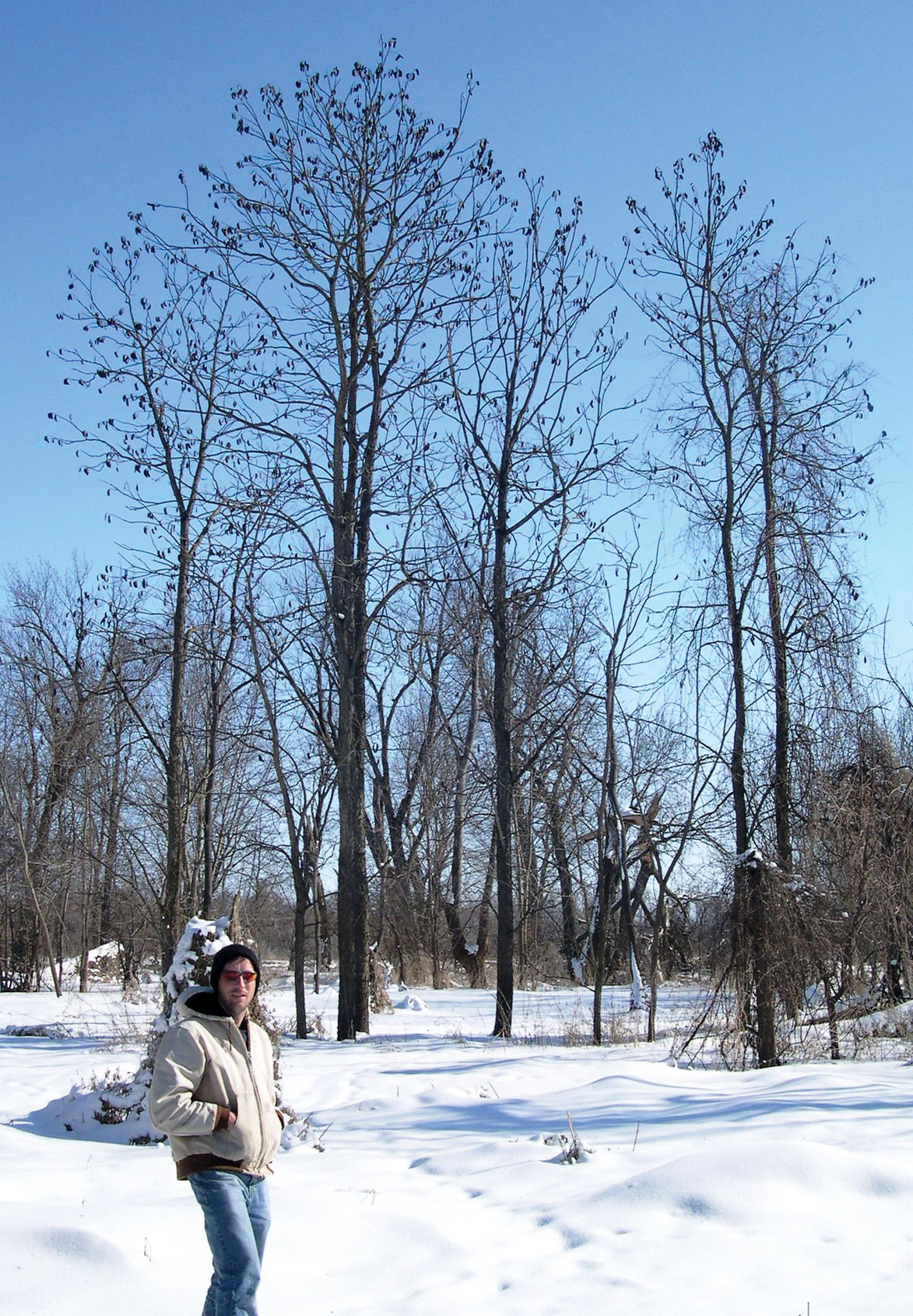

In addition to habitat losses like this, habitat modification poses another serious threat. Our main concern lies with Gymnocladus dioicus growing in floodplains of major watersheds. Thirty percent of our collections came from sites like this, but given that 82 percent of these plants were restricted to extremely well-drained soils, a slight change in hydrology (including increased frequency or duration of floods) would significantly impact tree health. At the Michigan sites where we observed serious signs of dieback and root rot, we also noted a number of uprooted specimens with debarked trunks lying in water, their root bases sticking eight feet in the air. These collapsed specimens likely resulted from hydrological changes, given that we found fruiting trees on slightly higher ground a few yards away. For a species that comprises only a small percentage of forest canopies, any loss is critical to future conservation.
The threat of non-native invasive species (and even aggressive natives) is also significant. Nowhere was this more evident than on the Little Red River near Heber Springs, Arkansas, where back in 2010 it was virtually impossible to not get entangled in Japanese honeysuckle (Lonicera japonica) or bloodied by multiflora rose (Rosa multiflora). We also noted mature coffeetrees acting like trellises for grape (Vitis sp.) and poison ivy (Toxicodendron radicans) resulting in limb decline. That same year, we sampled a site along the Iowa River in Louisa County, Iowa, where we noted more than one hundred genetically distinct trees—the most coffeetrees we had ever seen in a single area. We could have literally collected truckloads of pods. However, when we returned to this location in 2016, we discovered that at least three-quarters of the coffeetrees were dead or in decline after becoming overgrown by hops (Humulus sp.). The area had also flooded numerous times, suggesting a simultaneous and significant change in hydrology. In these real-world situations, even if seeds could germinate or if clonal suckers sprouted, it seems unlikely a new generation of trees would ever have a chance to reach maturity.
Still Collecting
Despite threats to native populations of Gymnocladus, we have consistently observed the extreme toughness and adaptability of the species. Not only can it tolerate a wide variety of soils, but the trees are remarkably durable, withstanding severe ice and other unfavorable weather conditions. When we visited Obion County, Tennessee, in February 2010, we crossed the mighty Mississippi on the Dorena-Hickman Ferry and witnessed the aftermath of a major storm that had deposited over an inch of ice a year before our visit. The forest was entangled with downed trees and limbs. Most trees were uniformly broken off at a certain height, but fifteen coffeetrees stood undamaged, towering above the surrounding mess and calling like beacons to two boys from Iowa.
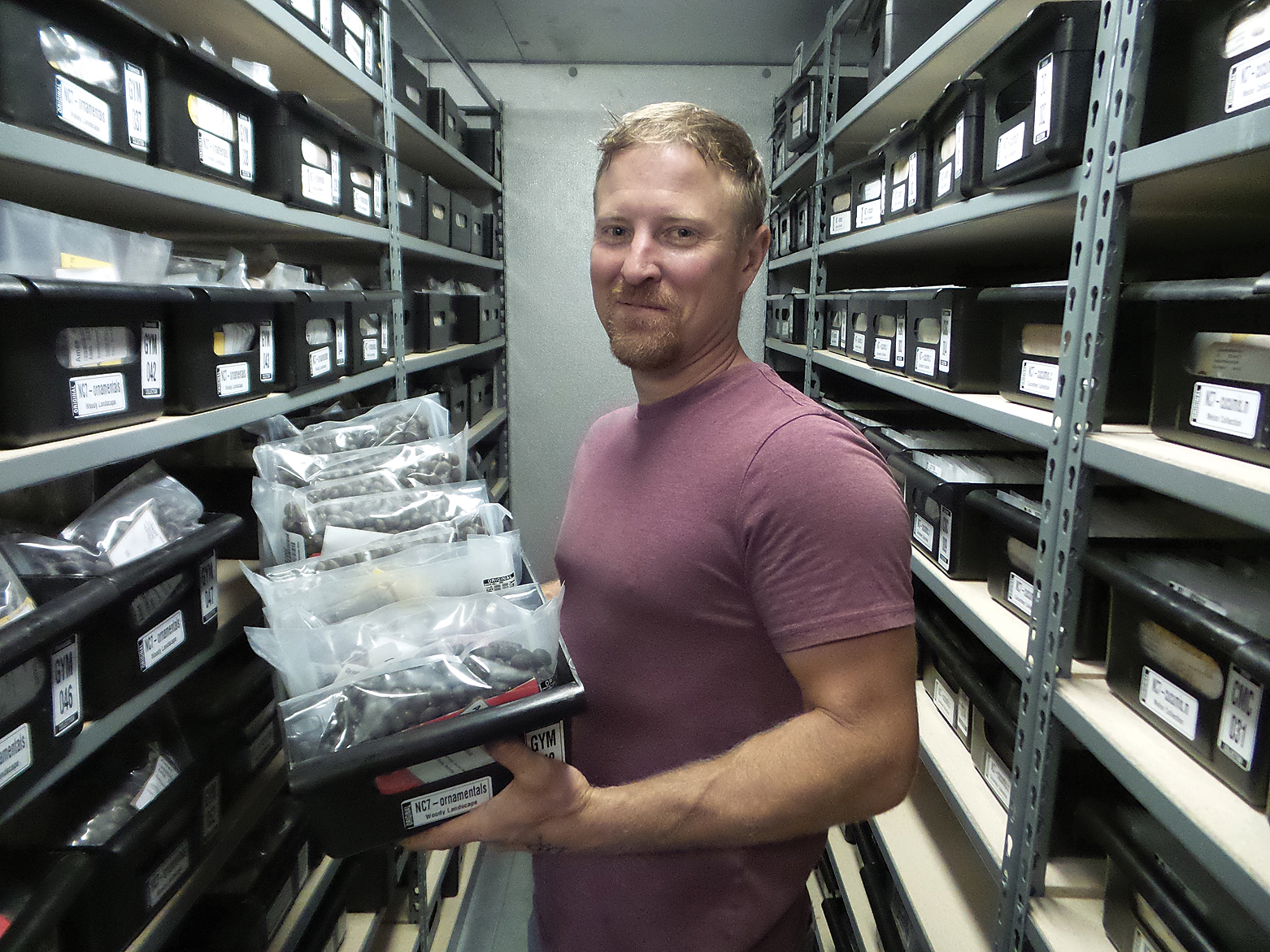

Over the past ten years, our travels have taken us across sixteen states in search of this one species: Gymnocladus dioicus. We have spent eight hours on a frigid boat ride on Michigan’s Shiawassee River to document the species for a new county record. We have tested the shocks on our minivan after collecting 1,335 pounds of pods during our trip to Texas and back. We have avoided snow storms in northern Arkansas, but in Kentucky, we collected in the pouring rain. We have worn hip waders too many times to count and used scrapers to clear ice off the inside of the windshield (given the condensation that rises from wet pods stored inside the van). We met an oilman in Oklahoma who just so happened to have a coffeetree pod under the seat of his truck because he wanted someone to identify it for him. We’re sure he never thought two guys from Iowa would make the positive determination, let alone two guys from Iowa who just so happened to be on the same backroad shaking the exact same pods from a tree. Our names are now linked to state champion coffeetrees in Kentucky, New York, and Oklahoma.
All told, we’ve travelled over twenty-five thousand miles and spent seventy-five days on the road, collecting over a quarter million seeds from more than five hundred mother trees. This has resulted in one of the most comprehensive tree seed collections ever preserved, including 88 seed accessions in the NPGS (GRIN, Online Database, National Genetic Resources Laboratory 2018) and 130 accessions of different wild provenances planted in three informal groupings at the Brenton Arboretum. Researchers in Ontario, Canada, are already using this expansive collection for genetic comparisons to their threatened native populations. In 2017, a replicated block of 750 trees was planted at the Plant Introduction Station in Ames, representing fifty wild populations (three mother trees per population and five trees per mother tree), which in time will help us to learn about pollinators, growth rates, and hardiness. Yet our fieldwork continues. We still aim to fill gaps within ecoregions and sample outlying populations and unique habitats. The state of Ohio is on our hit list because, to date, only one collection has been made there.
More than anything, our adventures have allowed us the opportunity to experience the beauty of this species in the wild and to discover more than what we could ever find in any textbook or publication. In the words of the natural historian William B. Werthner, “If in your walks through the woods, you chance to come upon a Kentucky coffeetree, count yourself fortunate for it is the rarest of our forest trees.” And if you do, please give us a call because we would sure like to know its location.
References
Barlow, C. 2001. Anachronistic fruits and the ghosts who haunt them. Arnoldia, 61(2): 14–21.
Barlow, C. 2008. The ghosts of evolution: Nonsensical fruit, missing partners, and other ecological anachronisms. New York: Basic Books.
Baskin, C. C. and J. M. Baskin. 1998. Seeds: Ecology, biogeography, and, evolution of dormancy and germination. San Diego: Academic Press.
Call, R. E. 1891. The geology of Crowley’s Ridge. Annual Report of the Geological Survey of Arkansas for 1889, 2: 1–223.
Carstens, J. and A. Schmitz. 2016. Michigan collection trip Gymnocladus dioicus. Technical Report to USDA-ARS Plant Exchange Office, National Germplasm Resources Laboratory, Beltsville, Maryland, 1–42.
Carstens, J. and A. Schmitz. 2015. Collection trip report Gymnocladus dioicus. Technical Report to USDA-ARS Plant Exchange Office, National Germplasm Resources Laboratory, Beltsville, Maryland, 1–57.
Carstens, J. and A. Schmitz. 2014. Collection trip report Gymnocladus dioicus. Technical Report to USDA-ARS Plant Exchange Office, National Germplasm Resources Laboratory, Beltsville, Maryland, 1–18.
Carstens, J. and A. Schmitz. 2013. Collection trip report Gymnocladus dioicus. Technical Report to USDA-ARS Plant Exchange Office, National Germplasm Resources Laboratory, Beltsville, Maryland, 1–54.
Carstens, J. and A. Schmitz. 2010. Collection trip report Gymnocladus dioicus. Technical Report to USDA-ARS Plant Exchange Office, National Germplasm Resources Laboratory, Beltsville, Maryland, 1–18.
Fordham, A. J. 1965. Germination of woody legume seeds with impermeable seed coats. Arnoldia,
25(1): 1–8.
Herendeen, P. S., Lewis, G. P., and A. Bruneau. 2003. Floral morphology in Caesalpinioid legumes: Testing the monophyly of the “Umtiza clade”. International Journal of Plant Sciences, 164(S5): 393–407.
Harshberger, J. W. 1904. The relation of ice storms to trees. Contributions from the Botanical Laboratory of the University of Pennsylvania, 2: 345–349.
Hauer, R. J., Wang, W., and J. O. Dawson. 1993. Ice storm damage to urban trees. Journal of Arboriculture, 19: 187–187.
Hoss, G. 2013. Growing difficult hardwoods: Experiences at the George O. White State Forest Nursery. National Proceedings: Forest and Conservation Nursery Associations–2012: 39.
Janzen, D. H. and P. S. Martin. 1982. Neotropical anachronisms: The fruits the gomphotheres ate. Science, 215(4528): 19–27.
Kartesz, J. T. 2015. The Biota of North America Program (BONAP). North American Plant Atlas. (http://bonap.net/napa). Chapel Hill, N. C. [maps generated from Kartesz, J. T. 2015. Floristic Synthesis of North America, Version 1.0. Biota of North America Program (BONAP). (in press)].
McClain, M. L. 1973. Site preferences and growth responses of Kentucky coffeetree, Gymnocladus dioicus (L.) K. Koch, near the center of its range (doctoral dissertation). Indiana State University, Terre Haute, Indiana.
McClain, M. L. and M. T. Jackson. 1980. Vegetational associates and site characteristics of Kentucky coffeetree, Gymnocladus dioicus (L.) K. Koch. Proceedings of the Central Hardwoods Forest Conference, 3: 239–256.
Omernik, J. M. 1987. Ecoregions of the conterminous United States. Annals of the Association of American Geographers, 77(1): 118–125.
Pinchot, G. 1907. Coffeetree (Gymnocladus dioicus). USDA Forest Service Circular, 91: 1–4.
Smith, M. A. L. 1996. Gymnocladus dioicus L. (Kentucky coffeetree). In Y. P. S. Bajaj (Ed.), Trees IV (pp. 194–204). New York: Springer-Verlag
Berlin Heidelberg.
Smith, W. R. 2008. Trees and shrubs of Minnesota. Minneapolis: University of Minnesota Press.
USDA, Agricultural Research Service, National Plant Germplasm System. 2018. Germplasm Resources Information Network (GRIN-Taxonomy). National Germplasm Resources Laboratory, Beltsville, Maryland. Accessed 1 May 2018 from https://www.ars-grin.gov/
USDA, Natural Resources Conservation Service, Soil Survey Staff. 2017. Web Soil Survey. National Soil Survey Center, Lincoln, Nebraska. Accessed 1 May 2018 from https://websoilsurvey.sc.egov.usda.gov/
USGS. 1999. Digital representation of “Atlas of United States Trees” by Elbert L. Little, Jr. Reston, Virginia: US Geological Survey.
Citation: Schmitz, A. and Carstens, J. 2018. Exploring the Native Range of Kentucky Coffeetree. Arnoldia, 76(1): 2–16.
Stilinovic, S. and M. Grbic. 1987. Effect of various presowing treatments on the germination of some woody ornamental seeds. International Symposium on Propagation of Ornamental Plants 226: 239–246.
Weisehuegel, E. G. 1935. Germinating Kentucky coffeetree. Journal of Forestry, 33: 533–534.
Werthner, W. B. 1935. Some American trees. New York: The Macmillian Company.
Zaya, D. N. and H. F. Howe. 2009. The anomalous Kentucky coffeetree: Megafaunal fruit sinking to extinction? Oecologia, 161(2): 221–226.
Andy Schmitz has been the director of horticulture/general manager of the Brenton Arboretum for twenty years and oversees all horticultural aspects of the 143-acre arboretum, including planting, curating, and maintaining all plant records for over 2,500 woody accessioned plants. He enjoys observing trees in their native habitats while collecting seed to grow trees and shrubs to enhance the arboretum’s collections, and his particular focus is on collecting the native Iowa woody plants for their Iowa collection.
Jeffrey Carstens is a horticulturist at the North Central Regional Plant Introduction Station in Ames, Iowa, where he currently serves as the curator for the collection of woody and herbaceous plants. He coordinates the NC-7 Woody Ornamental Evaluation Trials and is actively involved with collecting ash (Fraxinus) as part of the National Plant Germplasm System Ash Conservation Project.
From “free” to “friend”…
Established in 1911 as the Bulletin of Popular Information, Arnoldia has long been a definitive forum for conversations about temperate woody plants and their landscapes. In 2022, we rolled out a new vision for the magazine as a vigorous forum for tales of plant exploration, behind-the-scenes glimpses of botanical research, and deep dives into the history of gardens, landscapes, and science. The new Arnoldia includes poetry, visual art, and literary essays, following the human imagination wherever it entangles with trees.
It takes resources to gather and nurture these new voices, and we depend on the support of our member-subscribers to make it possible. But membership means more: by becoming a member of the Arnold Arboretum, you help to keep our collection vibrant and our research and educational mission active. Through the pages of Arnoldia, you can take part in the life of this free-to-all landscape whether you live next door or an ocean away.
